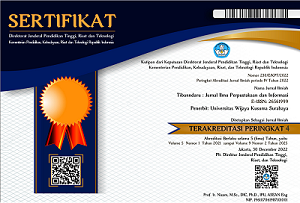The Effect of Library Website Quality on User Satisfaction Level in the Library of the University of Muhammadiyah Surakarta
Abstract
Purpose Research: This study aims to determine the influence of library website quality on the level of user satisfaction at the University of Muhammadiyah Library of Surakarta and uses the theory of Webqual 4.0 and End-User Computing Satisfaction (EUCS). Research Method: This study uses a quantitative method, and the research population is UMS students who have used the library website, with a sample of 268 respondents. The data collection technique uses a questionnaire disseminated online through social media and by visiting students in person. Analysis Data: Analysis data is processed by calculating mean and percentage and then matching the result with data interval. After that, data was counted with the normality test, correlation coefficient test, and hypothesis test. Result: The results showed that the usability indicator in the website quality variable obtained the highest average score of 3.18, and the service interaction quality indicator had the lowest average value with a value of 3.16. The ease of use indicator in the user satisfaction variable has the highest average value of 3.19. In contrast, the timeliness indicator has the lowest average value, with a value of 3.13. Conclusions: Based on the results of data analysis, it is known that the quality of the library website affects the level of user satisfaction at the University of Muhammadiyah Library Surakarta based on the results of the correlation coefficient test value of 0.971, which indicates a solid positive relationship.
Keywords: website quality; user satisfaction; Webqual 4.0; End-User Computing Satisfaction; EUCS)
Full Text:
PDFReferences
Ashari, M. R., Pradana, D. S., & Wahyuni, E. D. (2020). Evaluasi Kualitas Website Digital Library UMM Menggunakan Metode Webqual 4.0 Dan Importance Performance Analysis. Jurnal Repositor, 2(3), 351–362. https://doi.org/10.22219/repositor.v2i3.405
Choi, H., Park, J., & Jung, Y. (2018). The role of privacy fatigue in online privacy behavior. Computers in Human Behavior, 81, 42–51. https://doi.org/10.1016/j.chb.2017.12.001
Doll, W. J., & Torkzadeh, G. (1988). The Measurement of End-User Computing Satisfaction. MIS Quarterly, 12(2), 259. https://doi.org/10.2307/248851
Ghanad, A. (2023). An Overview of Quantitative Research Methods. INTERNATIONAL JOURNAL OF MULTIDISCIPLINARY RESEARCH AND ANALYSIS, 06(08). https://doi.org/10.47191/ijmra/v6-i8-52
Heo, M., Kim, N., & Faith, M. S. (2015). Statistical power as a function of Cronbach alpha of instrument questionnaire items Data analysis, statistics and modelling. BMC Medical Research Methodology, 15(1). https://doi.org/10.1186/s12874-015-0070-6
Hidayah, N. A., Fetrina, E., & Taufan, A. Z. (2020). Model Satisfaction Users Measurement of Academic Information System Using End-User Computing Satisfaction (EUCS) Method. Applied Information System and Management (AISM), 3(2), 119–123. https://doi.org/10.15408/aism.v3i2.14516
Husain, T., & Budiyantara, A. (2018). Analisis End-User Computing Satisfaction (EUCS) Dan WebQual 4.0 Terhadap Kepuasan Pengguna. JATISI (Jurnal Teknik Informatika Dan Sistem Informasi), 4(2), 164–176. https://doi.org/10.35957/jatisi.v4i2.99
Islam, J. U., Shahid, S., Rasool, A., Rahman, Z., Khan, I., & Rather, R. A. (2020). Impact of website attributes on customer engagement in banking: a solicitation of stimulus-organism-response theory. International Journal of Bank Marketing, 38(6), 1279–1303. https://doi.org/10.1108/IJBM-12-2019-0460
Kalkbrenner, M. T. (2021). A Practical Guide to Instrument Development and Score Validation in the Social Sciences: The MEASURE Approach. Practical Assessment, Research & Evaluation, 26(1).
Kato, A., Kisangiri, M., & Kaijage, S. (2021). A Review Development of Digital Library Resources at University Level. Education Research International, 2021, 1–13. https://doi.org/10.1155/2021/8883483
Kous, K., PuÅ¡nik, M., HeriÄko, M., & PolanÄiÄ, G. (2020). Usability evaluation of a library website with different end user groups. Journal of Librarianship and Information Science, 52(1), 75–90. https://doi.org/10.1177/0961000618773133
Lakens, D. (2022). Sample Size Justification. Collabra: Psychology, 8(1). https://doi.org/10.1525/collabra.33267
Lestari, D., Ilhamsyah, I., & Rusi, I. (2022). Pengukuran Kualitas Layanan Sistem Informasi Perpustakaan Universitas Tanjungpura Menggunakan Metode LibQual, WebQual 4.0, dan Importance Performance Analysis (IPA). Coding Jurnal Komputer Dan Aplikasi, 10(01), 34. https://doi.org/10.26418/coding.v10i01.52134
Longstreet, P., Brooks, S., Featherman, M., & Loiacono, E. (2021). Evaluating website quality: which decision criteria do consumers use to evaluate website quality? Information Technology & People, 35(4).
Manik, A., Salamah, I., & Susanti, E. (2017). Pengaruh Metode WebQual 4.0 Terhadap Kepuasan Pengguna Website Politeknik Negeri Sriwijaya. Jurnal Elektro Dan Telekomunikasi Terapan, 4(1), 477. https://doi.org/10.25124/jett.v4i1.994
MartÃnez-Caro, E., Cegarra-Navarro, J. G., & Alfonso-Ruiz, F. J. (2020). Digital technologies and firm performance: The role of digital organisational culture. Technological Forecasting and Social Change, 154, 119962. https://doi.org/10.1016/j.techfore.2020.119962
Ismatullah, N. K., Widodo, A. P., & Nugraheni, S. A. (2022). Model EUCS (End User Computing Satisfaction) untuk Evaluasi Kepuasan Pengguna Terhadap Sistem Informasi Bidang Kesehatan : Literature Review. Media Publikasi Promosi Kesehatan Indonesia (MPPKI), 5(5), 463–467. https://doi.org/10.56338/mppki.v5i5.2343
Obilor, E. I., & Amadi, E. C. (2018). Test for Significance of Pearson’s Correlation Coefficient. International Journal of Innovative Mathematics, Statistics & Energy Policies, 6(1), 11–23.
Perdana, I. A., & Prasojo, L. D. (2020). Digital Library Practice in University: Advantages, Challenges, and Its Position. Proceedings of the International Conference on Educational Research and Innovation (ICERI 2019). Paris, France: Atlantis Press. https://doi.org/10.2991/assehr.k.200204.009
Prianto, J. S. (2019). Optimalisasi Pemanfaatan Website Perpustakaan UII untuk Akses Informasi Digital. Buletin Perpustakaan, 2(2), 95–134. Retrieved from https://www.dosenpendidikan.
Rerung, R. R., Fauzan, M., & Hermawan, H. (2020). Website Quality Measurement of Higher Education Services Institution Region IV Using Webqual 4.0 Method. International Journal of Advances in Data and Information Systems, 1(2), 89–102. https://doi.org/10.25008/ijadis.v1i2.185
Saputra, A., & Kurniadi, D. (2019). ANALISIS KEPUASAN PENGGUNA SISTEM INFORMASI E-CAMPUS DI IAIN BUKITTINGGI MENGGUNAKAN METODE EUCS. Voteteknika (Vocational Teknik Elektronika Dan Informatika), 7(3), 58. https://doi.org/10.24036/voteteknika.v7i3.105157
Singh, A. S. (2017). Licensed under Creative Common Common Procedures for Development, Validity and Reliability of a Questionnaire. In International Journal of Economics, Commerce and Management United Kingdom. Retrieved from http://ijecm.co.uk/
Sugiyono. (2013). Metode Penelitian Kuantitatif, Kualitatif dan R&D. In Alfabeta, CV (Cetakan-19). Bandung: Alfabeta.
Thong, J. Y., Hong, W., & Tam, K. Y. (2002). Understanding user acceptance of digital libraries: what are the roles of interface characteristics, organizational context, and individual differences? International Journal of Human-Computer Studies, 57(3), 215–242.
Wulandari, E. R., Rizal, E., & Lusiana, E. (2021). Pengaruh kualitas website Kandaga terhadap kepuasan pengguna Perpustakaan Pusat Universitas Padjadjaran. Jurnal Kajian Informasi & Perpustakaan, 9(1), 79. https://doi.org/10.24198/jkip.v9i1.29146
DOI: http://dx.doi.org/10.30742/tb.v9i1.3958
Refbacks
- There are currently no refbacks.

This work is licensed under a Creative Commons Attribution-NonCommercial 4.0 International License.
Tibanndaru: Jurnal Ilmu Perpustakaan dan Informasi is indexing by:
Reference Management Tools

![]()


.png)







